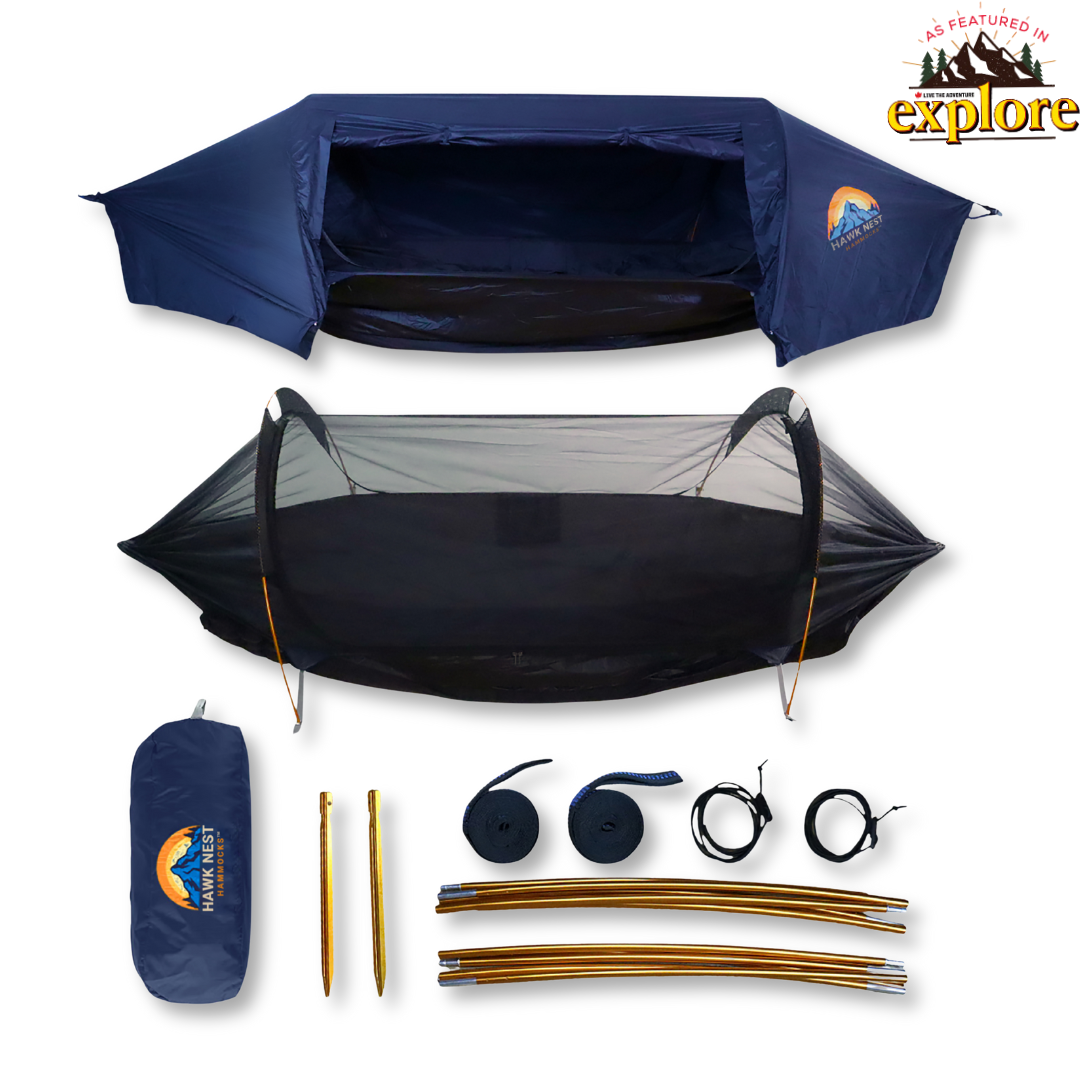Table of Contents
- Introduction to Lightweight Hammock Tents
- Benefits of Lightweight Hammock Tents
- Choosing the Right Lightweight Hammock Tent
- How to Set Up Your Lightweight Hammock Tent
- Frequently Asked Questions
Introduction to Lightweight Hammock Tents
Welcome to the world of lightweight hammock tents! If you're an outdoor enthusiast looking for a comfortable, portable, and eco-friendly camping solution, then lightweight hammock tents are perfect for you. These versatile tents offer a unique blend of comfort and convenience, making them a popular choice among campers, hikers, and backpackers.
Imagine exploring Canada's picturesque landscapes—from the majestic Rockies to the serene shores of its numerous lakes—and having a cozy, elevated sleeping spot wherever you go. Lightweight hammock tents allow you to camp almost anywhere, providing the freedom to experience nature up close while minimizing your impact on the environment.
In this guide, we'll delve into the benefits of lightweight hammock tents, how to choose the right one for your needs, tips for setting up, and more. Whether you're a seasoned camper or a newbie, you'll find valuable insights to enhance your camping adventures with a lightweight hammock tent.
Benefits of Lightweight Hammock Tents
Opting for a lightweight hammock tent offers numerous advantages that make your camping experience more enjoyable and hassle-free. Here are some key benefits:
Portability and Ease of Transport: Lightweight hammock tents are designed to be compact and easy to carry. When you're hiking or backpacking, every ounce counts. These tents can be packed down to a small size, fitting easily into your backpack or luggage, allowing you to travel light and move quickly.
Quick and Simple Setup: After a long day of exploring, the last thing you want is a complicated tent setup. Lightweight hammock tents are incredibly easy to set up, usually taking just a few minutes. All you need are two sturdy anchor points, such as trees or posts, and you're ready to relax.
Comfortable and Elevated Sleeping: Sleeping in a hammock tent provides a comfortable and elevated experience, free from the discomfort of rocky or uneven ground. Elevation also keeps you away from insects, dampness, and other ground-related nuisances, ensuring a better night's sleep.
Environmental Friendliness: Hammock tents have a minimal environmental impact compared to traditional tents. They don't require clearing the ground, which helps preserve natural habitats. By using a hammock tent, you're practicing Leave No Trace principles and helping to protect the environment.
Versatility and Flexibility: Lightweight hammock tents offer the flexibility to camp in a variety of locations. Whether you're in a dense forest, near a lakeshore, or on a mountainside, as long as there are anchor points, you can set up your hammock tent. This versatility opens up new possibilities for camping in unique and beautiful spots.
Overall, lightweight hammock tents enhance the camping experience by providing comfort, convenience, and a closer connection to nature. They are a fantastic option for those who love adventure and seek to minimize their ecological footprint.

Choosing the Right Lightweight Hammock Tent
When it comes to selecting the perfect lightweight hammock tent, several factors come into play. Here are some tips to help you make the best choice for your camping needs:
Material and Durability: Look for hammock tents made from high-quality, durable materials such as ripstop nylon or polyester. These fabrics are not only lightweight but also resistant to wear and tear, ensuring your hammock tent will last for many camping trips.
Weight and Packability: Consider the weight of the hammock tent when packed. It should be lightweight enough to carry without adding significant bulk to your gear. Check the packed size to ensure it fits comfortably in your backpack or motorbike storage.
Weight Capacity: Make sure the hammock tent can support your weight. Most lightweight hammock tents are designed for single users, but there are options available for two people. Always check the manufacturer's weight recommendations to ensure safety and comfort.
Setup Ease: Opt for a hammock tent that is easy to set up and take down. Features such as adjustable straps, quick-release carabiners, and clear instructions can make the process much simpler, especially after a tiring day.
Integrated Features: Many lightweight hammock tents come with integrated features like mosquito nets, rain flies, and storage pockets. These additions can greatly enhance your camping experience by providing protection from insects, weather, and offering convenient storage for small items.
Environmental Compatibility: Ensure that the hammock tent's straps and materials are tree-friendly to avoid damaging the bark of trees. This is crucial for maintaining the health of the natural environment where you camp.
By considering these factors, you can find a lightweight hammock tent that meets your needs and enhances your outdoor adventures. The right hammock tent can make all the difference in comfort, convenience, and overall enjoyment.
| Feature | Description | Benefits |
|---|---|---|
| Lightweight Material | Made from lightweight nylon or polyester. | Easy to carry, reduces fatigue. |
| Compact Design | Folds into a small package. | Fits easily in backpack or motorbike storage. |
| Integrated Mosquito Net | Mesh netting to protect against insects. | Allows for a peaceful sleep without bug bites. |
| Waterproof Cover | Includes a rain fly or waterproof top. | Keeps you dry during rain, enhancing comfort. |
| Easy Setup | Features adjustable straps and carabiners. | Can be quickly set up between two trees or posts. |
How to Set Up Your Lightweight Hammock Tent
Setting up your lightweight hammock tent is straightforward, but it's important to do it correctly for comfort and safety. Here’s a step-by-step guide to help you:
1. Choose the Right Location: Find a spot with two sturdy trees or posts about 10 to 15 feet apart. Ensure the area is flat and free from sharp objects that could damage your hammock or cause injury.
2. Inspect Your Equipment: Before setting up, inspect your hammock tent, straps, and carabiners for any wear and tear. This can prevent accidents and ensure a safe setup.
3. Attach the Straps: Wrap the straps around each tree at about eye level or higher. Make sure the straps are flat against the tree and securely fastened. This will provide a stable foundation for your hammock tent.
4. Hook the Hammock: Attach your hammock tent to the straps using the carabiners. Adjust the height and tension to your preference. Generally, a slight sag in the middle of the hammock provides the best comfort.
5. Test Your Hammock: Gently sit in your hammock to test its stability and comfort. Make adjustments as needed to ensure it is well-balanced and comfortable.
6. Add Accessories: If your lightweight hammock tent includes a mosquito net or rain cover, attach these elements once the hammock is stable. This will protect you from insects and weather conditions throughout your camping trip.
7. Final Checks: Double-check all connections and the hammock setup to ensure everything is secure. Look around the installation site one more time to confirm that there are no potential hazards like loose branches above your hammock.
By following these steps, you can set up your lightweight hammock tent quickly and enjoy a comfortable rest, whether you’re camping in a forest, by a lake, or in any serene outdoor setting. Proper setup is key to maximizing the enjoyment and functionality of your hammock tent, so take your time to do it right.
Frequently Asked Questions
What is the best way to choose a location for setting up my hammock tent?
Look for an area that is flat and free of sharp objects. The trees or posts you select for mounting the hammock should be sturdy and approximately 10 to 15 feet apart. Avoid areas under loose branches or near water bodies that might rise overnight.
How do I ensure my lightweight hammock tent is secure?
Always check the durability of the straps and the stability of the carabiners before setup. Ensure that the straps are tightly wrapped around the trees and the carabiners are properly closed. Test the hammock by gently sitting in it before fully lying down.
Can I use my hammock tent in rainy weather?
Yes, most hammock tents come with a rain fly to protect you from the rain. Make sure the rain fly is properly positioned and secured to avoid water pooling and to ensure it provides complete coverage.
Is it safe to camp alone using a hammock tent?
Camping alone can be safe if you take the proper precautions. Inform someone of your plans, bring necessary safety gear, and choose a well-traveled campsite if possible to ensure help is available if needed.
How do I pack my hammock tent on my motorbike?
Ensure that your hammock tent is compactly folded and securely fastened to your motorbike. Use waterproof bags to protect it from the elements during your ride. Balance the load to maintain stability while riding.
What accessories should I consider for my lightweight hammock tent?
Consider accessories like a thicker rain fly, an underquilt for colder weather, and a gear sling to keep your equipment off the ground. These additions can enhance comfort and functionality during your camping trip.
For more detailed information on setting up and choosing hammock tents, visit: Hammock Setup Guide and Choosing the Right Hammock.
Explore more tips and tricks for your camping adventures at: Mastering the Art of Hammock Tent Camping in Canada.
For the best lightweight hammock tents, visit: Hawk Nest Hammocks - Lightweight Hammock Tents.
For more information on our full range of products, visit our homepage: Hawk Nest Hammocks Home.


